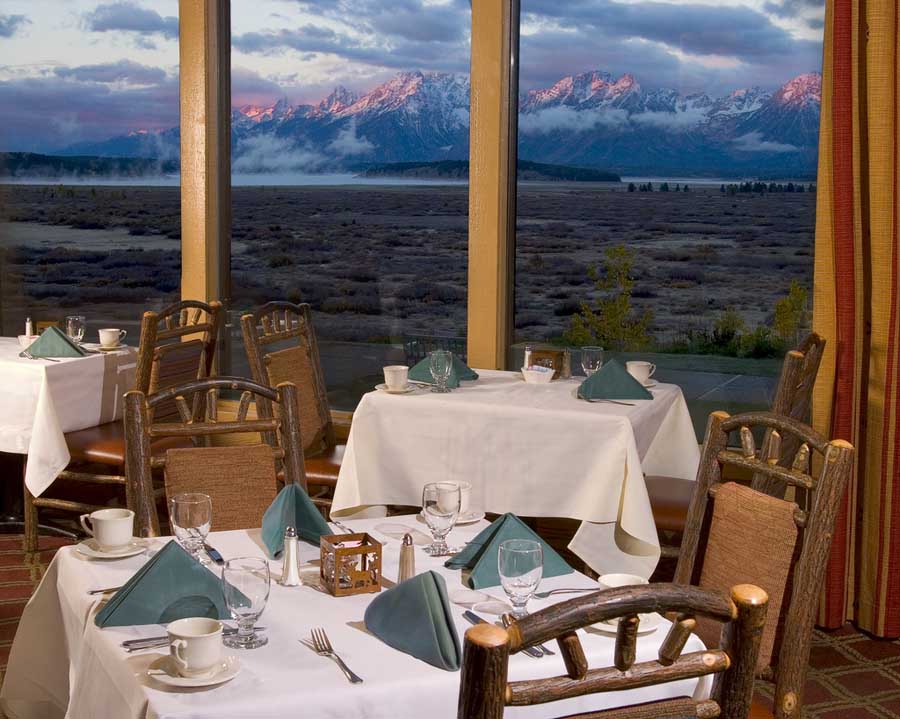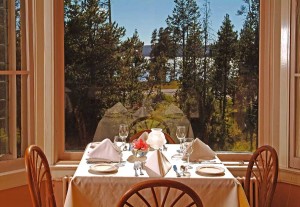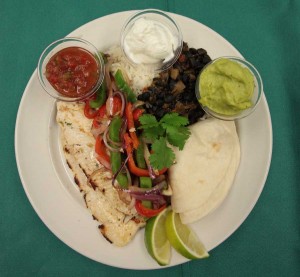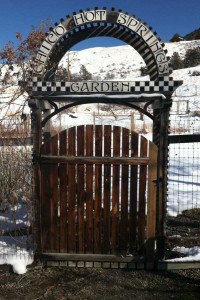
A rising interest among both restaurant owners and diners is driving a burgeoning movement in sustainable, farm-to-table dining around Yellowstone and Grand Teton national parks. As more producers and chefs make their operations greener, locals and visitors to the parks and their gateway communities have a growing number of choices for sustainable Yellowstone dining.
By Ruffin Prevost
PRAY, MONT. — In 1876, an early white settler in the Paradise Valley north of Yellowstone National Park pulled off a clever trick. He diverted water from a hot spring, routing it beneath his greenhouse to heat it year-round so he could sell vegetables to local residents.
A lot has changed since then at what is now Chico Hot Springs Resort, but they’re still using the hot spring water to heat a greenhouse and provide fresh vegetables, herbs and flowers for the guests.

“That’s a luxury, but it also allows you to have tremendous control over the quality of your ingredients,” said Colin Davis, general manager at Chico, a quirky and beloved retreat that was a popular campground in 1892, and has since operated as a boarding house, sanitarium, hotel and dude ranch before its present incarnation.
What started 136 years ago as a clever necessity for growing winter vegetables north of the 45th parallel has become a favorite example of one of the best practices in sustainable Yellowstone dining.
Though family-owned Chico is a regional leader in sustainable dining, it’s not alone. A rising interest among both restaurant owners and diners is driving a burgeoning movement in sustainable, farm-to-table dining around Yellowstone and Grand Teton national parks. As more producers and chefs make their operations greener, locals and visitors to the parks and their gateway communities have a growing number of choices for sustainable Yellowstone dining.

“We’re definitely seeing a much bigger interest in it now,” said Lill Erickson, executive director of the Western Sustainability Exchange, a Livingston, Mont. nonprofit group that helps connect environmentally responsible farmers and ranchers with restaurateurs who want to offer local, sustainably produced foods. Groups like WSE work to help promote farming and dining that: protects open space, wildlife habitat and water quality; treats animals humanely; and reduces or eliminates the use of hormones, antibiotics, chemical fertilizers and other synthetic additives to the food chain.
Though WSE has been around for 18 years, things have really taken off in the last five years, Erickson said, particularly at the three annual “commerce day” events the organization hosts, where local farmers and ranchers meet with chefs and Yellowstone food buyers.
It was at one of those events at Chico about five years ago that Yellowstone concessioner Xanterra Parks and Resorts connected with Sue and Melvyn Brown, owners of Amaltheia Dairy in Belgrade, Mont., west of Bozeman.
“It’s sort of like speed dating,” Xanterra’s Lu Harlow said of the Montana commerce days held in Billings, Bozeman and Missoula, where producers and purveyors try to make as many connections as possible during each event.
Xanterra Yellowstone ended up trying some of Amaltheia Dairy’s organic goat cheese, and now uses 1,700 pounds of it each year in salads and other dishes served throughout Yellowstone Park.
Harlow serves on the WSE advisory board, and is director of food and beverage operations in Yellowstone Park for Xanterra, the largest national and state park concessioner in the U.S.
Running Yellowstone dining operations and working under the scrutiny of the National Park Service, Xanterra makes environmental responsibility a corporate priority at a level most businesses can only imagine. Harlow is expected to serve quality food from local, sustainable sources, but she must deliver it at costs in line with regional competitors, as mandated by the Park Service.
Daunting logistics of sustainable Yellowstone dining
That’s not always an easy task at locations like the Old Faithful Snow Lodge, where every hamburger patty, head of lettuce, toothpick and napkin must be ferried in during winter via snow coach. Summer has its own challenges, when crushing throngs at popular spots like Old Faithful want a fast, affordable and tasty meal delivered just before the geyser blows, or within minutes of the latest eruption.
Harlow said the Old Faithful Inn may serve 2,500 meals in a single summer day, while Canyon Lodge, the busiest Yellowstone dining spot, can see more than 3,700 daily diners. Xanterra serves close to 2 million total meals in Yellowstone Park each year.
So Harlow has to be careful when working with small, family farms and ranches to ensure she has a reliable supply chain.

That often means starting small with a new vendor, perhaps offering the item as a special or limited-run item in just one dining location, she said.
When Harlow discussed serving fresh fish from Trout Culture in Virginia City, Mont., she said the business owners were enthusiastic about supplying “all the trout we need.” But with park visitors eating 26,500 pounds of trout each year, that wasn’t possible at first.
Xanterra initially listed fish from Trout Culture as a Yellowstone dining special on the Lake Hotel menu, and will be greatly expanding their trout offerings this year, Harlow said. Meeting demand for a highly perishable item like fish means working closely with the local supplier, but also flash-freezing some fish to ensure supply during the busiest Yellowstone dining times of the summer.
For ocean fish, both Xanterra and Grand Teton Lodge Company, a concessioner operating Jackson Lake Lodge and other properties in Grand Teton National Park, rely on certification and monitoring programs like the Marine Stewardship Council and Monterey Bay Aquarium Seafood Watch to ensure sustainable sources.
The volume of food both companies serve means they act as culinary “market makers” in remote, sparsely populated areas where fresh, local and sustainable have typically not been priorities for major food service companies.
Grand Teton Lodge Company challenged provider U.S. Foods to offer a wider variety of organic and sustainable foods, said Gina MacIlwraith, GTLC environmental, health and safety director.
“We gave them the market for this, so they were able to go out and know they had a buyer for these sustainable lines,” MacIlwraith said. The result has been that U.S. Foods now carries more such products, and makes them available at lower prices to restaurant customers throughout the region.

For some guests, eating sustainable food is a priority, while for others it’s not such a major concern, MacIlwraith said.
“We’ve found that what’s important for our guests is different for every person, so we focus on providing choices,” including healthy, homemade items made with organic ingredients and served at appropriate portion sizes, she said.
The company offers banquet, convention and meeting customers a range of food options, including choices highlighted for their sustainability, said Levi Thorn, director of sales and marketing.
Some sustainable food options on catering menus cost a bit more, while others may cost less, he said. So GTLC works to educate customers on why an item might be more expensive, and most people are usually open to paying a bit more for the greener option. The company also may offer a discount on other expenses like audio-visual equipment rental fees, for instance, as an incentive or perk for choosing sustainable menu items, Thorn said.
Sustainable dining goes beyond the farm and kitchen
For GTLC, Xanterra and Chico, sustainable dining doesn’t start at the farm and end on the plate. All three companies work to make their facilities energy efficient, to conserve water and to reduce waste.
Xanterra’s recent remodeling of the Mammoth Hotel dining room earned a 3-star certification from the Green Restaurant Association, the first such rating for a Wyoming eatery, and one of less than 75 awarded in the entire country.

The makeover for the Yellowstone dining room included installing energy-efficient LED lighting, low-flow plumbing fixtures and even bathroom stall partitions made from recycled materials.
Grand Teton Lodge Company works hard to minimize deliveries to cut down on traffic and transportation inefficiencies. The company also subsidizes park shuttle services for employees and provides free transit passes to guests.
At Chico, most of the table scraps are sent home with about a half-dozen employees who use them in small-scale poultry operations, and the company is exploring options for contracting with those workers for fresh eggs.
Such companies set the tone for other travel and hospitality businesses operating in the region, said Janice Brown, executive director of the Yellowstone Business Partnership, a regional nonprofit group that promotes sustainable business practices.
“Certainly, the concessioners in the parks are leaders in that, and Chico was among the first to go through Uncommon Sense,” a lengthy and intensive YBP sustainability leadership program, Brown said.
“There is a growing interest in sustainability, including among travelers looking for sustainable tours and other options,” Brown said. “I don’t think it would be happening if there wasn’t some demand.”
Forty-eight percent of Yellowstone Gate readers in a recent non-scientific poll said they strongly favor businesses with solid sustainability policies. But Yellowstone dining companies must be careful in how they communicate sustainability information to customers, Brown said.
Both Brown and Western Sustainability Exchange’s Erickson said companies must work to figure out the best ways to let customers know about their practices and policies. But how to do that without the effort being counterproductive can be tricky.
“They have to tell their story in a way that makes the most sense for them,” Brown said.

For savvy businesses, that often means a small note somewhere on a menu or a sign in a dining room, but otherwise letting guests learn about green initiatives through personal interactions with staff members or from other customers. Some consumers are suspicious of green claims, especially after enduring “greenwashing” campaigns from big companies looking to cash in on customers’ environmental concerns without doing the hard work that goes along with responsible practices.
“We’re not doing it because it’s a nice marketing tool,” said Dylan Hoffman, director of environmental affairs in Yellowstone for Xanterra. “It’s a core value of who we are as a company.”
“For us, we live by a mission of ‘preserve, protect and inspire,'” said Thorn of GTLC. “We understand we live in a beautiful, wonderful natural environment, and we’re passionate about caring for it.”
“We’re just caretakers of Chico,” Davis said. “This place attracts people who care for it.”
Dating back to the first settler who used the hot springs for his greenhouse, “we’re always inspired by the hot water,” Davis said. “Our job is to leave it better than we found it, and we do that because it’s the right thing to do.”
Contact Ruffin Prevost at 307-213-9818 or [email protected].

Congrats to the Yellowstone and Teton area lodges who are using sustainable dining. Not only is it health conscience but also helps in the local economy. When diners hear about where their food is coming from I think it makes for a more enjoyable experience.